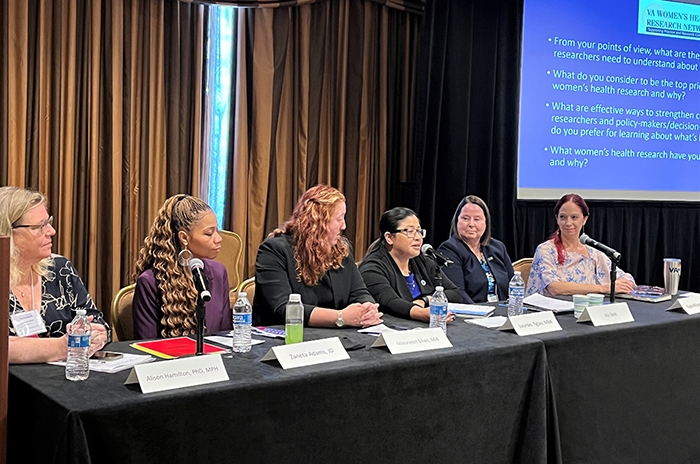Office of Research & Development |
 |
Office of Research & Development |
 |


A VA case review led by Avery Laliberte of VA Portland showed missed opportunities to screen a patient for thoughts of suicide in multiple visits to the emergency department. (Photo for illustrative purposes only: ©Getty Images/Nes)
April 11, 2022
By Mike Richman
VA Research Communications
"There's an argument to be made for screening anyone who comes into the ED for suicidal ideation. Universal screening has been shown to dramatically increase detection of those at risk."
In the United States, one of every 10 adults who dies by suicide is seen in an emergency department within two months before their death. Despite national guidelines for suicide screening, risk assessment, and follow-up care, including those from the Joint Commission and Emergency Nurses Association, suicidal thoughts and behavior continue to go undetected in emergency departments, leading to gaps in care.
Avery Laliberte, a study coordinator at the Center to Improve Veteran Involvement in Care at the VA Portland Health Care System, has been researching the issues of social connection and community engagement among Veterans at high risk for suicide and suicide loss. She also studies health care use among Veterans.

Avery Laliberte
She led a case review that highlighted missed opportunities to screen a Veteran for suicidal ideation—thoughts of taking one’s own life—and to provide appropriate follow-up care during an emergency department (ED) visit.
The case review, part of a larger study on ED care, appeared in the Journal of Emergency Nursing in November 2021.
The patient was a white man in his early 40s. He reported being a Navy Veteran experiencing chronic homelessness, with a history of anxiety and PTSD. He had no family or friends and said he was not receiving VA benefits.
Laliberte and her team first identified an index visit where the patient visited a non-VA emergency department during the period of Jan. 1, 2017—Jan. 1, 2018. Records showed he had attempted suicide and went to a large community hospital to be treated for his injuries.
Using the patient’s electronic health record, the researchers reviewed all medical visits in the six months prior to that index visit and the six months after. The chart review showed that he checked into an ED nine times over a one-year period—using four different non-VA hospitals. He was not screened for thoughts of suicide in any of those visits, despite one incident where he was hit by a slow-moving train in a suicide attempt.

VA Researcher Named One of U.S.’ Top Female Scientists

2023 VA Women's Health Research Conference

Self-harm is underrecognized in Gulf War Veterans

Virtual reality technology helps Veterans in pain
“Universal suicide screening in EDs is feasible and can double the detection of those at risk. Consequently, guidelines at the national and state levels encourage emergency departments to enhance risk assessment and follow-up care,” Laliberte and her colleagues wrote. “As this case review highlights, implementation of these guidelines and formal training in how to care for suicidal patients in the emergency department is limited. Not screening for [suicidal ideation] and assessing risk can lead to missed opportunities to provide follow-up care, as shown in this case review.”
Suicide prevention is VA’s top clinical priority. VA’s 2021 National Veteran Suicide Prevention Annual Report notes that in 2019—the most recent year for which data are available—the age- and sex-adjusted suicide rate for Veterans declined 7.2% compared to the prior year. Still, the 2019 Veteran suicide rate was 31.6 per 100,000, much higher than the rate of 16.8 per 100,000 among non-Veteran U.S. adults.
“Screening for [suicidal ideation] and assessing suicide risk is especially important in emergency departments, where prevalence of those at risk of suicide is high and where emergency nurses play an important role because of their routine contact with suicidal patients,” Laliberte’s team wrote. “Hospital systems should continue to train in these areas to aid emergency nurses in identifying available clinical tools for screening and risk assessment, embedding these processes into their workflow and ultimately improving care for suicidal patients.”
Laliberte spoke with VA Research Currents:
VA Research Currents: What influenced you to pursue this case review, and what were you trying to accomplish?
Laliberte: In my first two years in our research lab headed by Dr. Jason Chen at VA Portland, we conducted hundreds of chart reviews of patients who screened positive for suicidal ideation in two emergency departments—one in a VA hospital and one in a community hospital. We reviewed the electronic medical records of these patients to evaluate the care they received, looking specifically for care recommended for patients who screen positive for suicidal ideation. In nearly all these cases, we saw a lack of documentation of suicide safety plans, suicide screening, and risk assessment, as well as other gaps in recommended care. We felt that writing up this case study would be a good way to highlight these missed opportunities in the emergency department, point out scenarios where enhanced care could have been offered, and provide context to help readers understand the patient’s experience and the emergency department environment.
Were you surprised to find out that the patient in the case review was not screened for suicide in any of his nine visits to an ED?
When reviewing this patient’s record, I was not surprised by the lack of documentation of suicide screening in any of the nine visits. This patient was one of hundreds of other charts we reviewed, and unfortunately, this lack of screening was not unique. While there are reports of EDs screening for suicide less than is recommended, it’s important to note that for this case study, we only had access to what was documented in the medical record. It’s possible that the patient was screened during the study period and the provider did not document the screening in the medical record. However, just as using validated suicide screening and risk assessment is important for getting patients the care they need, it’s also important to document this screening and risk assessment so future providers can know if a patient may be at higher risk.
Studies indicate that one in 10 people who die by suicide are seen in an ED within two months of their death. Is that a large percentage?
Ten percent is a large percentage from my perspective. That’s about 4,600 people each year who are seen in the ED within two months of their death. Each of those instances is an opportunity to identify whether someone is at risk and get them the appropriate follow-up care. Additionally, not all of those who are seen in the ED in the two months prior to their death by suicide are coming to the ED for mental health concerns. I think in these cases, it can be difficult for providers to know whether the patient is at risk, especially if they aren’t sure how or when to conduct screening, and may not have adequate support in this area.
Is there a way to get more people who are at risk for suicide to be seen in EDs?
I wouldn’t advocate for getting more people at risk for suicide to be seen in the ED. If someone is in crisis and needs immediate support, for example, if someone is having a psychotic episode and expresses intent to attempt suicide, then going to the ED would make sense. For those who are at risk more generally, or chronically, I would advocate for them to be seen on a regular basis by an outpatient mental health provider and to access other resources, such as the National Suicide Prevention Lifeline [800-273-8255] or the American Foundation for Suicide Prevention’s resources. While there are opportunities to catch patients in the ED who may be at risk, the emergency department is not the best place for things like ongoing mental health care. It would be more effective for someone who is seeking psychotherapy, for example, to start with these other resources rather than going to the ED.
How do you know when a patient is thinking of suicide? How do you know when to screen someone for suicide risk?
The short answer is whenever! It never hurts to ask someone if they are thinking about suicide. While there is no wrong time to screen someone for suicide, there are warning signs that someone might be thinking about it, such as talking about dying, having no reason to live, or feeling like a burden to others. Someone who might be thinking about suicide also might start withdrawing from family and friends or giving away their possessions.
If someone gives no indication that they are thinking of suicide, how does someone in an ED know to screen for suicidal ideation?
There’s an argument to be made for screening anyone who comes into the ED for suicidal ideation. Universal screening has been shown to dramatically increase detection of those at risk. States also have recommendations for when to screen in the ED. In Oregon, for example, it’s recommended that anyone who comes into the ED with a behavioral health crisis should be screened for suicidal thoughts. State recommendations aside, providers may decide to screen if they know the patient has characteristics that put them at higher risk of suicide than the general population, examples would be when a person is a Veteran, or is experiencing homelessness or substance use disorder. This is known as selective screening. A provider might also decide to screen patients if they are known to be at high risk of dying by suicide because, for example, they have attempted suicide in the past. This is called indicated screening.
Overall, I think EDs can provide more training and support to their staff to make them feel more comfortable conducting these screenings.
Editor’s Note: If you or someone you know is having thoughts of suicide, contact the Veterans Crisis Line, which is available 24 hours a day, seven days a week, at 1-800-273-8255 and press 1. You can also text 838255 or chat online at veteranscrisisline.net/chat.
VA Research Currents archives || Sign up for VA Research updates